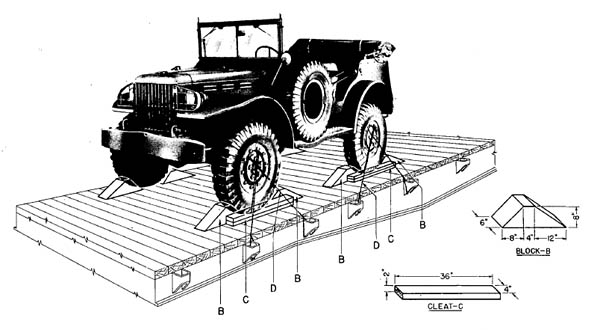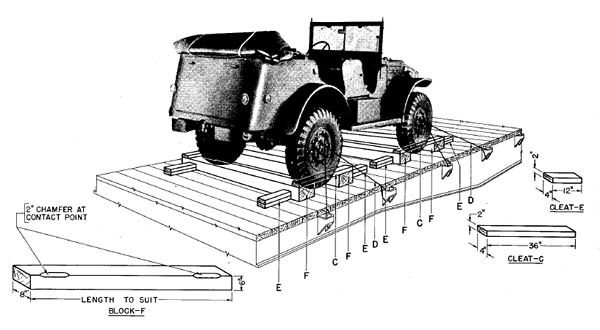Instructions for storage and shipment of the Dodge weapons carrier and variants (WC-51 through WC-60) from TM 9-808: ¾-Ton 4×4 Truck (Dodge), War Department Technical Manual, January 1944.
STORAGE AND SHIPMENT
194. STORAGE AND SHIPMENT (GENERAL).
a. The 3/4-ton truck will usually be shipped uncrated for domestic shipment. For overseas shipment trucks will usually be shipped crated in pairs. Preparation for temporary storage (less than 60 days) will be the same as preparation for domestic shipment, and preparation for indefinite storage (over 60 days) will be the same as the preparation for overseas shipment.b. Preparation for Domestic Shipment and Temporary Storage.
(1) LUBRICATION. Lubricate the vehicle completely before storage or shipment.
(2) FUEL IN TANKS. It will not be necessary to remove the fuel from the tanks nor to label these tanks under Interstate Commerce Commission Regulations.
(3) WATER IN RADIATOR. Drain the radiator only when there is a possibility of freezing during storage or shipment. If the water is drained from the radiator, tie a conspicuous tag to the steering wheel of each vehicle indicating that the radiator is empty.
(4) BATTERY. Disconnect the battery by removing the positive battery cable. Tape the cable and tie it away from the battery.
(5) UNPAINTED SURFACES. Treat all unpainted and exposed surfaces with rust-preventive before the vehicle is stored or shipped. After cleaning the surface with solvents or a soap, solution, treat all exterior surfaces with a thin film of rust-preventive compound. Apply preventive cold by spraying or brushing. It will harden to a tough thin film. Treat surfaces from which it would be difficult to remove rust-preventives, such as the bore of a gun, with rust-preventive compound, light. Apply this compound by brushing or slushing.
(6) TIRES. For domestic shipment, inflate the tires to about 10 pounds above normal.
(7) INSPECTION. Make systematic inspection just before shipment or storage. Make a list of all missing items or broken items that are not repaired, and attach the list to the steering wheel.
c. Preparation for Overseas Shipment and Indefinite Storage.
Observe all precautions given in paragraph 194b in preparation for overseas shipment and indefinite storage. Many additional precautions must be taken, especially for overseas shipment. (See AR 850-18.)
195. SPECIAL PRECAUTIONS FOR STORAGE.
a. Take the following precautions when the truck is prepared for storage.b. Engine.
(1) Check the engine oil and replenish if necessary.
(2) Remove the air cleaner from the carburetor.
(3) Start the engine and run it at a fast idle, spraying approximately one pint of lubricating oil preservative (medium) into the carburetor throat. Turn off the ignition switch immediately after the oil has been sprayed into the carburetor.
(4) With the ignition switch off, open the throttle wide and turn the engine over several complete revolutions by means of the starting motor.
(5) Install the air cleaner.
c. Brakes. Release the brakes and block the wheels.
d. Inspections.
(1) Inspect the vehicles weekly for tire leaks or discharged batteries.
(2) Upon removal from storage, repair or replace any items noted on the tag attached to the steering wheel as still needing repair or still missing, and perform a complete monthly maintenance inspection.
196. METHODS OF SECURING VEHICLE ON FREIGHT CARS.
a. There are two approved methods of blocking the 3/4-ton trucks on freight cars as described below.b. Method 1 (fig. 209).
(1) BLOCKS B. Place eight blocks B to the front and to the rear of each front wheel and to the front of each forward rear wheel, and to the back of each rearward rear wheel. Nail the heel of the block to the car floor with five 40-penny nails, and toenail that portion of the block under the tire to the car floor with two 40-penny nails. CAUTION: Nail blocks B in such a position that cleats C will clear face of tires by 1/2 inch.
(2) CLEATS C. Place two cleats C against the outside face of blocks B at each front and rear wheel. Nail the lower cleats to the car floor with three 40-penny nails and the top cleat to the cleats below with three 40-penny nails. Fill the 1/2-inch space between tires and cleats C with burlap or other similar material to prevent chafing of tires.
(3) STRAPPING D. Pass four strands, two wrappings, of No. 8 gage, black annealed wire (D, fig. 209) through the spokes of the wheels and the stake pockets. Tighten the wires enough to remove slack. If a box car is used, apply this strapping in similar fashion and attach it to the floor by the use of blocking or anchor plates. This strapping is not required when gondola cars are used.
c. Method 2 (fig. 210).
(1) BLOCKS F. Place one block F across the front and one across the rear of the front wheels. Place one block F to the front of the forward rear wheels and one block F to the rear of the rearward rear wheels. These blocks must be at least eight inches wider than the over-all width of the vehicle at the car floor.
(2) CLEATS E. Place sixteen cleats E against blocks F, as shown in figure 210.
(3) CLEATS C. Wrap cleats C with burlap or other similar material to prevent chafing of tires. Place one cleat C against the outside of each front wheel on the top of block F, as shown in figure 210. Nail the cleats to each block F with two 40-penny nails.
(4) STRAPPING D. Pass four strands, two wrappings, of No. 8 gage, black annealed wire (D, fig. 210) through the spokes of the wheels and the stake pockets. Tighten the wires enough to remove slack. If a box car is used, apply this strapping in similar fashion and attach it to the floor by the use of blocking or anchor plates. This strapping is not required when gondola cars are used.
197. OVERSEAS SHIPMENT.
a. The truck will usually be crated for overseas shipment to protect the truck, to reduce cubic measurement, and to facilitate stowage. Usually this crate will be made up as a twin pack; that is, containing two vehicles broken down as much as necessary in order to save cubic displacement. When such crating is necessary, it should be performed in accordance with IOSSC-(a), “Introduction to Ordnance Storage and Shipment Chart, Section (a), Instructions and Specifications for Packaging Ordnance General Supplies.”
198. SHIPMENT WITH COMBAT UNITS.
a. Shipping of Vehicles, Combat Loaded.(1) Do not disassemble the vehicle. Protect unpainted surfaces with lubricating oil preservative.
(2) BLOCKING. Whenever possible, use blocking similar to that shown in figures 212 and 213. However, special precautions must be taken to prevent the materiel from moving sideways.
b. Protection During Shipping.
(1) MATERIALS AVAILABLE. Keep a supply of the required cleaning and preserving materials available for servicing while in transit.
(2) DECK LOADS. When the materiel is shipped on deck, cover the vehicle with a closely fitting tarpaulin. Seal all engine openings, such as the carburetor, air intake, exhaust outlet, oil breather outlet, etc., with waterproof tape. Apply this sealing so that it is easily accessible without disassembly in order that the vehicle may be ready for immediate action.
c. Inspections. Make daily inspections for signs of corrosion which should be checked immediately by reapplication of rust-preventives and lubricating oil. Do not allow salt water to dry on unprotected surfaces under any circumstances. If possible, after the materiel has been subjected to salt water flush the materiel with clean, fresh water.












Thanks for the post, this helps with some research I was doing for my model project.